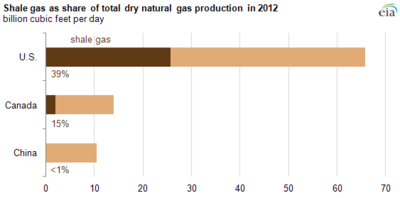
Back غاز الأردواز Arabic Лупняковы газ BE-X-OLD Шистов газ Bulgarian পাথুরে গ্যাস Bengali/Bangla Gas de lutita Catalan Břidlicový plyn Czech Сланец газĕ CV Skifergas Danish Schiefergas German Skistogaso Esperanto
The examples and perspective in this article may not represent a worldwide view of the subject. (February 2022) |



Shale gas is an unconventional natural gas that is found trapped within shale formations.[1] Since the 1990s a combination of horizontal drilling and hydraulic fracturing has made large volumes of shale gas more economical to produce, and some analysts expect that shale gas will greatly expand worldwide energy supply.[2]
Shale gas has become an increasingly important source of natural gas in the United States since the start of this century, and interest has spread to potential gas shales in the rest of the world.[3] China is estimated to have the world's largest shale gas reserves.[4]
A 2013 review by the United Kingdom Department of Energy and Climate Change noted that most studies of the subject have estimated that life-cycle greenhouse gas (GHG) emissions from shale gas are similar to those of conventional natural gas, and are much less than those from coal, usually about half the greenhouse gas emissions of coal; the noted exception was a 2011 study by Robert W. Howarth and others of Cornell University, which concluded that shale GHG emissions were as high as those of coal.[5][6] More recent studies have also concluded that life-cycle shale gas GHG emissions are much less than those of coal,[7][8][9][10] among them, studies by Natural Resources Canada (2012),[11] and a consortium formed by the US National Renewable Energy Laboratory with a number of universities (2012).[12]
Some 2011 studies pointed to high rates of decline of some shale gas wells as an indication that shale gas production may ultimately be much lower than is currently projected.[13][14] But shale-gas discoveries are also opening up substantial new resources of tight oil, also known as "shale oil".[15]
- ^ "U.S. Energy Information Administration". Eia.gov. Retrieved 6 August 2013.
- ^ Krauss, Clifford (9 October 2009). "New way to tap gas may expand global supplies". The New York Times. Retrieved 6 August 2013.
- ^ Cite error: The named reference
Chatham_Aug2012was invoked but never defined (see the help page). - ^ Staff (5 April 2011) World Shale Gas Resources: An Initial Assessment of 14 Regions Outside the United States US Energy Information Administration, Analysis and Projections, Retrieved 26 August 2012
- ^ David J. C. MacKay and Timothy J. Stone, Potential Greenhouse Gas Emissions Associated with Shale Gas Extraction and Use, 9 September 2013. MacKay and Stone wrote (p.3): "The Howarth estimate may be unrealistically high, as discussed in Appendix A, and should be treated with caution."
- ^ Howarth, Robert; Sontaro, Renee; Ingraffea, Anthony (12 November 2010). "Methane and the greenhouse-gas footprint of natural gas from shale formations" (PDF). Springerlink.com. Retrieved 13 March 2011.
- ^ Burnham and others, "Life-cycle greenhouse gas emissions of shale gas, natural gas, coal, and petroleum", Environmental Science and Technology, 17 January 2012, v.46 n.2 p.619-627.
- ^ Keating, Martha; Baum, Ellen; Hennen, Amy (June 2001). "Cradle to Grave: The Environmental Impacts from Coal" (PDF). Clean Air Task Force. Archived from the original (PDF) on 4 October 2013. Retrieved 2 October 2013.
- ^ James Conca, Fugitive Fracking Gets Bum Rap, Forbes, 18 February 2013.
- ^ Why Every Serious Environmentalist Should Favour Fracking Archived 12 July 2017 at the Wayback Machine, 2013 report by Richard A. Muller and Elizabeth A. Muller of Berkeley Earth
- ^ Natural Resources Canada, Shale gas Archived 21 December 2013 at the Wayback Machine, 14 December 2012.
- ^ Jeffrey Logan, Garvin Heath, and Jordan Macknick, Elizabeth Paranhos, William Boyd, and Ken Carlson, Natural Gas and the Transformation of the U.S. Energy Sector: Electricity, Technical Report NREL/TP-6A50-55538, Nov. 2012.
- ^ David Hughes (May 2011). "Will Natural Gas Fuel America in the 21st Century?" Post Carbon Institute, [1]
- ^ Arthur Berman (8 February 2011). "After the gold rush: A perspective on future U.S. natural gas supply and price". Theoildrum.com. Retrieved 6 August 2013.
- ^ Syed Rashid Husain. "Shale Gas Revolution Changes Geopolitics." Saudi Gazette. 24 February 2013. [2] Archived 18 April 2013 at archive.today